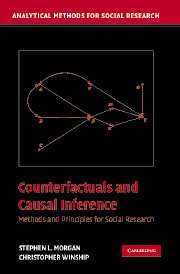Book contents
- Frontmatter
- Contents
- Acknowledgments
- Part 1 Counterfactual Causality and Empirical Research in the Social Sciences
- Part 2 Estimating Causal Effects by Conditioning
- 3 Causal Graphs, Identification, and Models of Causal Exposure
- 4 Matching Estimators of Causal Effects
- 5 Regression Estimators of Causal Effects
- Part 3 Estimating Causal Effects When Simple Conditioning Is Ineffective
- Part 4 Conclusions
- References
- Index
3 - Causal Graphs, Identification, and Models of Causal Exposure
Published online by Cambridge University Press: 05 June 2012
- Frontmatter
- Contents
- Acknowledgments
- Part 1 Counterfactual Causality and Empirical Research in the Social Sciences
- Part 2 Estimating Causal Effects by Conditioning
- 3 Causal Graphs, Identification, and Models of Causal Exposure
- 4 Matching Estimators of Causal Effects
- 5 Regression Estimators of Causal Effects
- Part 3 Estimating Causal Effects When Simple Conditioning Is Ineffective
- Part 4 Conclusions
- References
- Index
Summary
In this chapter, we present the basic conditioning strategy for the identification and estimation of causal effects. After introducing a methodology for building causal graphs, we present what has become known as the back-door criterion for sufficient conditioning to identify a causal effect. We then present models of causal exposure, introducing the treatment assignment and treatment selection literature from statistics and econometrics. We then return to the back-door criterion and discuss the two basic motivations of conditioning – balancing determinants of the cause of interest and adjusting for other causes of the outcome. We conclude with a discussion of the identification and estimation of conditional average causal effects by conditioning.
Causal Graphs and Conditioning as Back-Door Identification
In his 2000 book titled Causality: Models, Reasoning, and Inference, Judea Pearl lays out a powerful and extensive graphical theory of causality. Here, we present and use only the most basic elements of his theory. To the reader familiar with traditional linear path models, much of this material will look familiar. There are, however, important and subtle differences between traditional path models and Pearl's usage of directed acyclic graphs (DAGs).
Pearl's work provides a language and a framework for thinking about causality that differs from the potential outcome perspective presented in the last chapter. Beyond the alternative terminology and notation, Pearl (2000, Section 7.3) proves that the fundamental concepts underlying the potential outcome model and his more recent perspective are equivalent.
- Type
- Chapter
- Information
- Counterfactuals and Causal InferenceMethods and Principles for Social Research, pp. 61 - 86Publisher: Cambridge University PressPrint publication year: 2007
- 1
- Cited by

